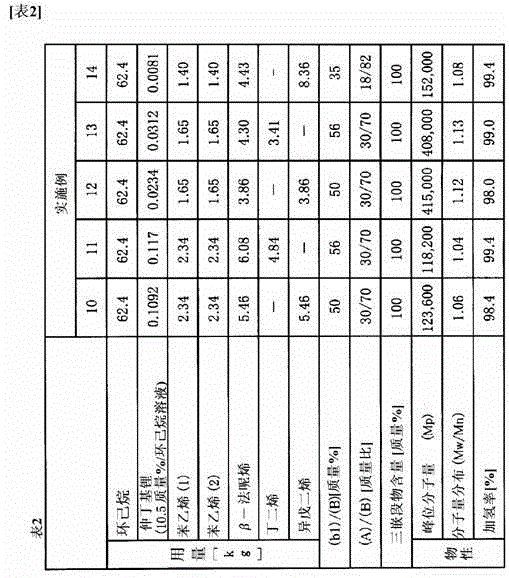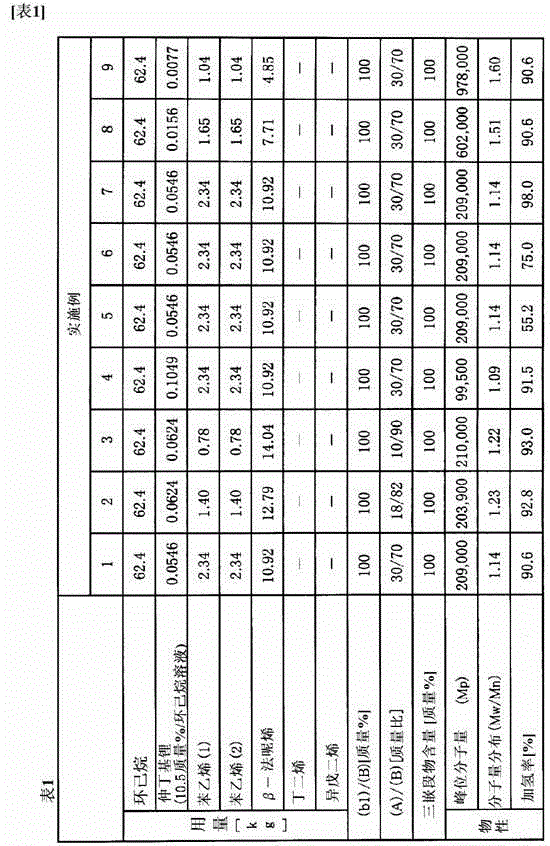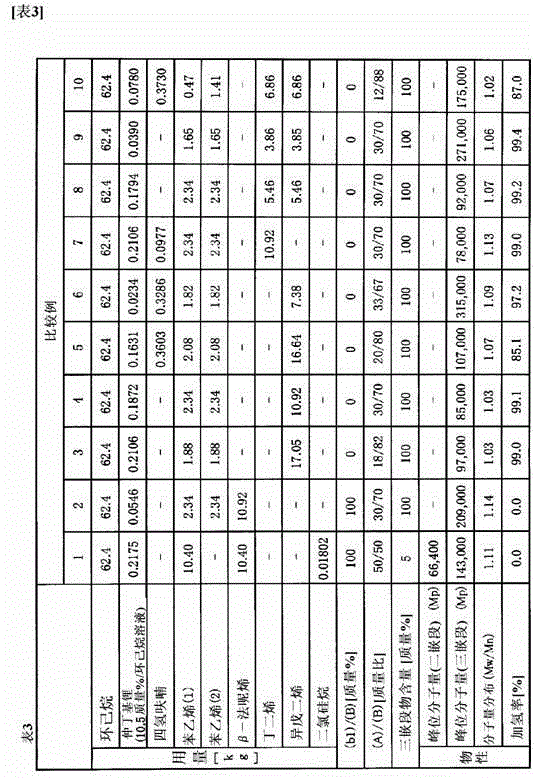Hydrogenated block copolymer and method for producing same
A technology of block copolymers and hydrogenated blocks, applied in the field of hydrogenated block copolymers, can solve problems such as insufficient research on practical properties, and achieve the effects of excellent rubber elasticity and excellent weather resistance.
- Summary
- Abstract
- Description
- Claims
- Application Information
AI Technical Summary
Problems solved by technology
Method used
Image
Examples
Embodiment 1
[0104] 62.4 kg of cyclohexane as a solvent and 54.6 g of sec-butyllithium (10.5% by mass cyclohexane solution) as an anionic polymerization initiator were put into a pressure-resistant container replaced with nitrogen and dried, and the temperature was raised to 50°C. , add 2.34 kg of styrene (1) and polymerize it for 1 hour, then add 10.92 kg of β-farnesene and polymerize for 2 hours, then add 2.34 kg of styrene (2) and polymerize for 1 hour to obtain A reaction solution containing a polystyrene-poly(β-farnesene)-polystyrene triblock copolymer (hereinafter referred to as a block copolymer (P1)). 5% by mass of palladium on carbon (loaded palladium: 5% by mass) as a hydrogenation catalyst was added to the reaction solution, and the reaction was carried out under the conditions of hydrogen pressure 2 MPa and 150°C. 10 hours of response. After standing to cool and releasing the pressure, the palladium carbon was removed by filtration, the filtrate was concentrated, and then vacu...
Embodiment 2~9
[0106] Except having followed the compounding described in Table 1, it carried out similarly to Example 1, and produced hydrogenated block copolymer (HP2)-(HP9). The above-mentioned evaluation was performed about the obtained hydrogenated block copolymers (HP2)-(HP9). The results are shown in Table 1 and Table 4.
Embodiment 10
[0108] 62.4 kg of cyclohexane as a solvent and 109.2 g of sec-butyllithium (10.5% by mass cyclohexane solution) as an anionic polymerization initiator were put into a pressure-resistant container replaced with nitrogen and dried, and the temperature was raised to 50°C. , add 2.34 kg of styrene (1) and allow it to polymerize for 1 hour, then add a mixture of 5.46 kg of β-farnesene and 5.46 kg of isoprene, perform polymerization for 2 hours, and then add 2.34 kg of styrene (2) , polymerized for 1 hour to obtain a reaction comprising polystyrene-poly(β-farnesene / isoprene)-polystyrene triblock copolymer (hereinafter referred to as block copolymer (P10)) liquid. 5% by mass of palladium-on-carbon (loaded palladium: 5% by mass) as a hydrogenation catalyst was added to the reaction solution, and the hydrogenation pressure was 2 MPa at 150° C. for 10 hours of response. After cooling and releasing the pressure, remove the palladium carbon by filtration, concentrate the filtrate, and t...
PUM
| Property | Measurement | Unit |
|---|---|---|
| diameter | aaaaa | aaaaa |
| diameter | aaaaa | aaaaa |
| peak molecular weight | aaaaa | aaaaa |
Abstract
Description
Claims
Application Information
 Login to View More
Login to View More - R&D
- Intellectual Property
- Life Sciences
- Materials
- Tech Scout
- Unparalleled Data Quality
- Higher Quality Content
- 60% Fewer Hallucinations
Browse by: Latest US Patents, China's latest patents, Technical Efficacy Thesaurus, Application Domain, Technology Topic, Popular Technical Reports.
© 2025 PatSnap. All rights reserved.Legal|Privacy policy|Modern Slavery Act Transparency Statement|Sitemap|About US| Contact US: help@patsnap.com



